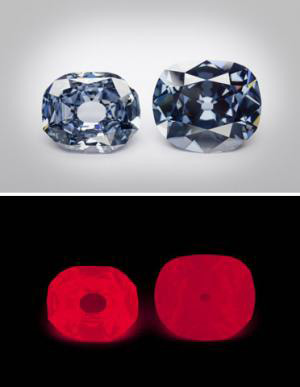Last chance to see rare blue diamond
The Museum of Natural History is extending its exhibit of one of the most rarely seen gems in the world, the Wittelsbach-Graff Diamond, to Sept. 1. Before the diamond was exhibited beginning Jan. 28, it had been out of view from the public eye for more than 50 years. It had previously been on public display at the Brussels World’s Fair in 1958.
The Wittelsbach-Graff Diamond is in the Harry Winston Gallery in the museum, adjacent to the renowned Hope Diamond, in the Hall of Geology, Gems and Minerals.
As a rare blue diamond from the 17th century, the Wittelsbach-Graff Diamond’s properties once suggested a possible link to the same mines in India that produced the 45.52-carat Hope Diamond, the near-perfect example of a deep-blue diamond. However, this has been dispelled by Jeffrey Post, the museum’s curator of gems and minerals. “There is an uncanny resemblance, but they are different,” said Post. “They are not part of the same crystal or rough. Perhaps they are distant cousins but not brothers and sisters.”
The Wittelsbach-Graff Diamond has a rich history, beginning in 1664 when Philip IV of Spain gave it to his daughter, the Infanta Margarita Teresa, on her engagement. In 1722, the diamond passed to the Wittelsbachs, members of the ruling House of Bavaria. After World War I, the crown jewels of the House of Wittelsbach were sold at Christie’s in 1931 by auction.

The Wittelsbach-Graff diamond (31.06 ct, left) and the Hope diamond (45.52 ct, right) apparently were not cut from the same crystal, even though they share several similarities, such as strong red phosphorescence (bottom). (Photos by Chip Clark)
Inexplicably, the Wittelsbach-Graff Diamond disappeared before the auction and was replaced by a worthless glass replica. It resurfaced in Belgium in 1951 and was eventually displayed—without attribution—at the “World Exhibition” in Brussels in 1958. The diamond was correctly identified in 1962 by Joseph Komkommer, a Belgian gem expert.
In December 2008, the 35.56-carat stone was acquired by Laurence Graff, at auction in London. Graff’s expertise in gemology enabled him to see the potential in repolishing the stone. The process brought the stone to its current weight of 31.06 carats. According to the Gemological Institute of America, the diamond “… is the largest Flawless or Internally flawless, Fancy Deep Blue, Natural Color we have graded to date…”
Posted: 12 August 2010
- Categories:




